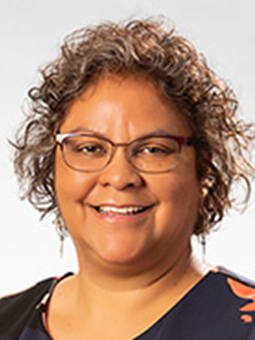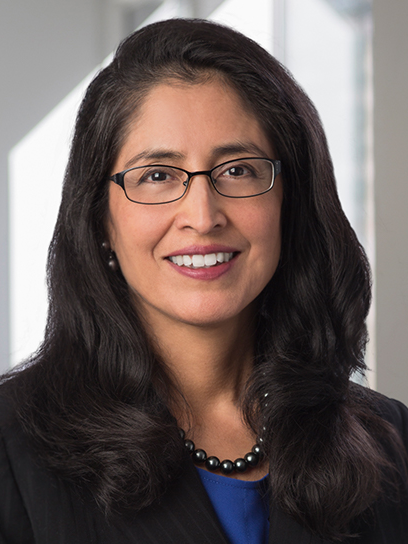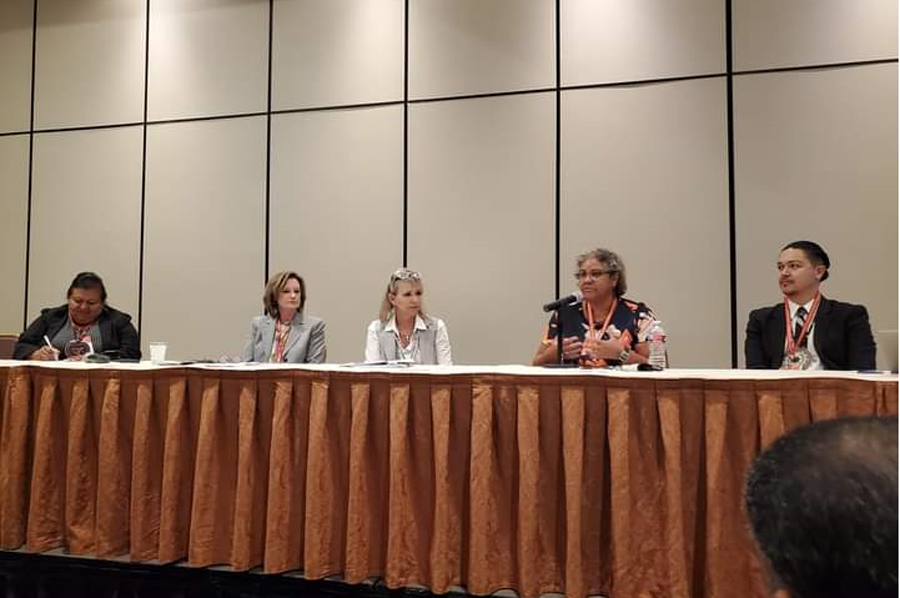 Pilar Thomas, Pascua Yaqui Tribe, among the many achievements in her career, has coordinated federal agency policies and efforts in tribal energy development, worked in the U.S. Departments of Justice (DOJ) and Energy (DOE) and served as the Deputy Solicitor of Indian Affairs for the Department of the Interior (DOI). She focuses her current legal work at Energy, Environment & Natural Resources Practice Group on renewable energy and economic development, working on transmission lines, solar, wind and natural gas on tribal lands. Thomas serves on the board of trustees for Rocky Mountain Mineral Law Foundation and on the board of directors (BOD) of GRID Alternative.
Pilar Thomas, Pascua Yaqui Tribe, among the many achievements in her career, has coordinated federal agency policies and efforts in tribal energy development, worked in the U.S. Departments of Justice (DOJ) and Energy (DOE) and served as the Deputy Solicitor of Indian Affairs for the Department of the Interior (DOI). She focuses her current legal work at Energy, Environment & Natural Resources Practice Group on renewable energy and economic development, working on transmission lines, solar, wind and natural gas on tribal lands. Thomas serves on the board of trustees for Rocky Mountain Mineral Law Foundation and on the board of directors (BOD) of GRID Alternative.
 Hilary Tompkins, Navajo Nation, works on both conventional and renewable energy resources and her successes stretch from supporting the first renewable projects on public lands to legal reforms after Deepwater Horizon. She is the former Solicitor for the DOI, the agency responsible for the management of public lands, and served as the Trustee for Native American tribes. She currently is a partner at Hogan Lovells Law Firm and serves as the first Native American on the board of trustees for Dartmouth College and on the BOD of the Environmental Law Institute (ELI).
Hilary Tompkins, Navajo Nation, works on both conventional and renewable energy resources and her successes stretch from supporting the first renewable projects on public lands to legal reforms after Deepwater Horizon. She is the former Solicitor for the DOI, the agency responsible for the management of public lands, and served as the Trustee for Native American tribes. She currently is a partner at Hogan Lovells Law Firm and serves as the first Native American on the board of trustees for Dartmouth College and on the BOD of the Environmental Law Institute (ELI).
The BOD of both the non-profit organizations that Thomas and Tompkins support are diverse and work on leadership opportunities for minorities and women. Both organizations also help facilitate the energy transition on tribal lands. GRID Alternatives (GRID) works to make renewable energy technology and job training accessible to underserved communities across the nation. As a board member, Thomas supports all aspects of the organization along with its tribal program across California, South Dakota and Navajo lands. GRID envisions EV infrastructure, rooftop solar and a certain percentage of President Biden’s infrastructure plan to be spent in low-income areas.
Environmental Law Institute (ELI) conducts outreach to up and coming environmental lawyers through education and webinars to “make the laws work for people, places and the planet.” ELI’s Climate and Energy Program addresses the threat of climate change and the opportunities of new energy sources. A goal is to enhance resiliency of communities and to ensure new energy sources like wind and solar can be exploited in a sustainable manner.
Thomas and Tompkins agree that getting on a board is dependent on relationships. As Solicitor for DOI, Tompkins had wide visibility and was invited to serve. From her experience, she sees that building a network is key to getting on a board and that those who strive for leadership roles must start this linkage early.
“What I didn’t really understand as a young person was about building relationships and a community of support,” she admits. Noting that this skill is something “you don’t learn about in school,” she encourages young women to think about this at the front end of their careers.
Thomas had a similar path to gaining her board position by keeping up her connections. “When I worked at DOE, I did projects with GRID and its fledgling tribal program. When I left DOE, I stayed in touch. I joined the advisory committee, then when a board position opened up, they asked me to come onto the board.”
Both female leaders feel sitting on a non-profit board is a great experience and a way to open up future opportunities. A non-profit board can be a stepping-stone to corporate boards if that is your interest. Tompkins explains, “There is an evolution occurring on corporate boards. In the past, you had to be a private sector executive to get invited on a corporate board, but that guiding principle excludes a lot of experienced individuals from the government and non-profit segments, who are also BIPOC.” She is encouraged to see these corporate boards “casting a wider net,” even if by external levers and pressure from stakeholders, beyond shareholders, who want to see more board diversity. And she relates, “More evidence shows there are negative financial implications of not having a diverse board.”

Thomas’ focus is the non-profit sector, so a corporate board is not an immediate goal. She doesn’t see a lot of Native American women with the goal to join a corporate energy board with one of the majors, seeing it as a bit of a “sell out” to their communities to work in “brown energy” (coal, oil and gas).
Tompkins points out, “This is a time of transition to a clean energy economy and a lot of tribes are excited to be a part of it.” She explains how tribal lands are ripe for development of solar and wind projects and says Native Americans will be a key part of President Biden’s Building Back Better program, whether it’s in battery storage, transmission infrastructure, carbon capture or sharing traditional knowledge of living in a sustainable manner.
Other tribes have a fossil fuel history. “For my tribe, Navajo,” Tompkins says, “we’ve had coal and oil and gas royalties. I went to college on a scholarship based on coal royalties. I couldn’t have afforded college without it.”
Thomas voices that some tribes are tepid about getting involved in the energy transition. “What do we do for oil and gas workers and communities who depend on revenue and taxes from the oil and gas industry? I help guide my clients through this to take advantage of their land and infrastructure being built to become part of the clean energy economy.”
Tompkins adds that we need to listen to tribal leaders on how to make the energy transition and still insure people have jobs and income. She sees that in the energy transition we need people with a variety of skills – lawyers, engineers, designers and construction workers. “We need an alternative economy along with alternative energy.”
Thomas’ vision is that one gigawatt of solar is deployed throughout Indian Country in four years. “I see solar on every rooftop!” she says enthusiastically. She envisions tribes involved in every part of the clean energy business, from manufacturing to assembly to design to project development – participating in this industry and not being left behind. That can happen with land, resources, access to the grid and new transmission lines.
We need more Native American women as leaders in the energy transition and Tompkins and Thomas offer wise words to younger women on how to get there. Tompkins asserts, “Go to college, get education and strive for leadership positions. And when you get one, get support –from a coach, colleagues – for your gaps.” She confesses, “I didn’t love public speaking when I first started out, but I got support and it’s gotten better over the years. When you are a ‘first’ – first Native this, first African American that – it’s a lot of pressure. You need to get support.”
Thomas encourages Native American women to “develop a network, advertise yourself, be out there and get known. You have to build a pipeline.” She recognizes that she’s still getting known. “It takes a long time.”
Thomas continues, “Not many Native American kids want to go into the energy business. Most want to go back and work for their tribe and they want to make a difference right out of the gate.” She sees energy as a booming area and encourages them to explore it. She notes that the energy transition will take a while, so young people must have patience. “You need to stick to it. It takes some gray hair; it’s not a cataclysmic change.”
“Nobody’s perfect out of the gate,” Tompkins concedes. “I learned on the job, built resiliency and toughness that is part of what you need to continue and persevere.”
And when you achieve that first board position, Tompkins advises, “First, you need to really understand the organization you are representing. You also need to understand the perspectives of other board members and find synergies. You don’t want to go in and declare edicts your first day.”
She explains, “As a board member, you bring a piece of the pie, but not the whole pie. There’s a lot of pie-making that goes on when you’re on a board. The goal is not to burn the pie.”
Native American women have much to offer the energy transition. Tompkins eloquently defines this statement, “Native women bring a traditional knowledge of how to live sustainably in balance with Mother Earth. They bring unique skills in building consensus and thinking about future generations. They have experience working on complex, intergenerational issues but with an eye towards reconciliation and healing.”
She explains that a lot of tribal traditions are about how to solve disputes – the Navajos call it “peacemaking.” And, she concludes, “There needs to be some peacemaking on these energy transition issues to find a collaborative path forward.”
“We are in for an interesting ride!” Thomas proclaims. “Native people have a huge opportunity in the energy transition.”
Headline photo – Former Deputy Solicitor of Indian Affairs for the Department of the Interior (DOI) Hilary Tompkins. Photo courtesy of Dept. of Justice – Justice.gov.
Lucinda Jackson is the author of the memoir Just a Girl: Growing Up Female and Ambitious about her struggles to succeed in male-dominated work settings. As a Ph.D. scientist and global corporate executive, Jackson spent almost fifty years in academia and Fortune 500 companies. She has published articles, book chapters and patents, and is featured on podcasts and radio. She lives near San Francisco and is the founder of Lucinda Jackson Ventures, where she speaks and consults on empowering women in the workplace. Connect with Jackson or find her book at: https://lucindajackson.com
Oil and gas operations are commonly found in remote locations far from company headquarters. Now, it's possible to monitor pump operations, collate and analyze seismic data, and track employees around the world from almost anywhere. Whether employees are in the office or in the field, the internet and related applications enable a greater multidirectional flow of information – and control – than ever before.



